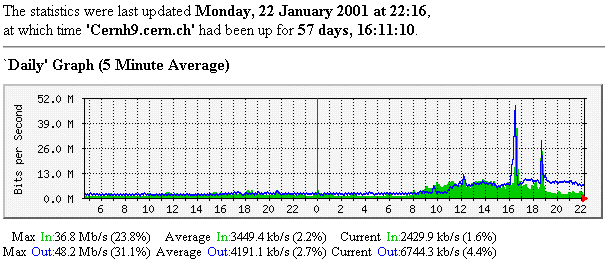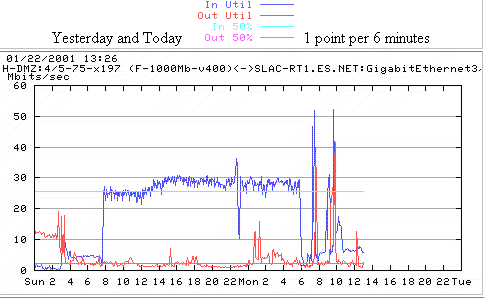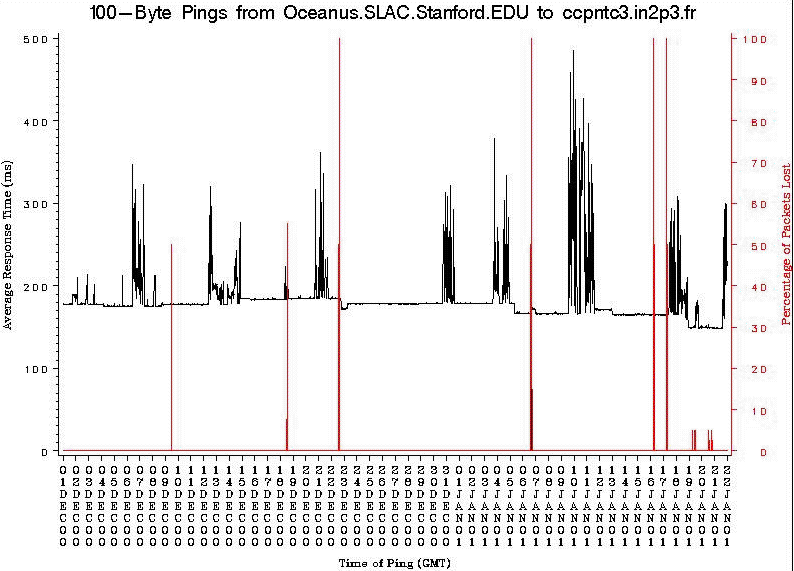Network connectivity between SLAC and IN2P3, Lyon, France, Jan 2001

Les Cottrell.
Page created: January 22, 2001. Last update 1/30/01
Central Computer Access | Computer Networking | Network Group | ICFA-NTF Monitoring
|
|
Network connectivity between SLAC and IN2P3, Lyon, France, Jan 2001
Les Cottrell.
Page created: January 22, 2001. Last update 1/30/01
|
|
We start to use the new link Friday January the 19. What we discover is that we have an asymmetric throughput. We are experiencing : 20 Mbps SLAC/LYON 29 Mbps LYON/SLAC This asymetrie was already found in May last year between SLAC and CERN and was never solved. The trouble ticket was TTS#6229 and Mike Collins was taking care of it. I have made mesureament between SLAC and CERN. The common path is then STARTAP,ESNET,SLAC and I get the same asymmetrie : CERN/SLAC : from 40 Mbps to 46 Mbps SLAC/CERN : from 23 Mbps to 29 MbpsThe utilization of the utilization of the 155Mbps link between CERN and KPN is shown below.


An earlier (December 2000) study of the connectivity between these sites is available at Network connectivity between SLAC and IN2P3, Lyon, France.
We looked at the Surveyor's one way loss and delay measurements between SLAC and CERN. These measurements are made roughly once/second/direction so in a complete day there would be about 86000 measurements. The measurements for January 14th, 15th, 16th, 2001 (the most recent available) showed no losses in either direction apart from a brief interruption on the 15th of a bout 15 minutes when there was 100% packet loss from CERN to SLAC. Measurements are not made when the GPS clocks are not available for synchronizing the measurements.
The pingroutes between the two sites indicate the losses are less than 1% (i.e. no losses in 100 pings) (the apparent loss from IN2P3 to RTR-MSFC-DMZ.slac.stanford.edu is due to the way the router is configured).
The pchar path characteristics measured from SLAC to IN2P3 indicate that the bottleneck bandwidth to the IN2P3 site is about 30Mbps and is between the chi-snv.es.net and 192.70.69.14 192.70.69.14 is a PHYnet (as789) router interface of a p2p peering at AADS with ESnet. PHYnet pcr/scr is set to 40Mbps/30Mbps where CERN's pcr/scr is 149m/149m. This bottleneck limit is roughly confirmed by the bulk throughput measurements between SLAC and IN2P3 made by Gilles. We also used pipechar to charaerize the path. The pipechar results also show an ~30Mbps bottleneck close to ccasn01.in2p3.fr. The variability of the pipechar results (measured minutes apart) make one suspicious of how much one can read into them.
The problem have been solved after making change on the definition on the PVC between IN2P3 and ESnet (migrating the Renater part to ubr+ and changing the vbr caracteristic of the ESnet side). We have now the max throughput of 32 Mbps ATM SLAC/IN2P3 30 Mbps ATM IN2P3/SLAC As the router on the ESnet side is not able to run ubr+ we now have stop our changes.
